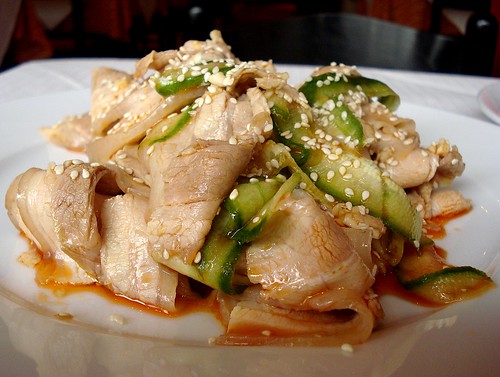While some Chinese pork dishes, such as 紅燒肉 (hóng shāo ròu/red-cooked pork), require long cooking in a flavourful liquid to get the meat tender and tasty, others are based on the very straightforward procedure of simply boiling the pork in plain water. The result of this is 白肉 (bái ròu) — 白 means plain/white/pure, and 肉 is meat (remember, in the absence of a qualifier, this means pork).
This might not sound overly exciting, but it's actually not too dissimilar to the idea of Western cold cuts — plainly-cooked meat enlivened with some good, strong flavourings. Indeed, the particular dish I'm posting about today is a really tasty one that if done properly will leave you stinking of garlic for some time afterwards.
蒜泥白肉 (suàn ní bái ròu) is a cold dish (涼菜/liáng cài) of sliced pork slathered in a sauce based on mashed/minced garlic (蒜/suàn). There are many, many ways to make this sauce. Eating Club Vancouver has two versions of 蒜泥白肉, one of which grinds the garlic in the blender for a thicker, more homogeneous sauce. Soy sauce is a common ingredient; conversely, the version pictured above was flavoured very simply with chopped garlic in chilli oil.
The sauce I use is adapted from a book I found on Google Books (although it's bilingual inside, it doesn't appear to have an English title — the Chinese title is given as 培梅名菜精選: 川浙菜專輯). It's based on a sweetened soy sauce, which you can make by gently simmering 200ml soy sauce with 150g sugar, 4 Tbsp Shaoxing wine, 1 sliced spring onion, 1 slice of ginger, 1 piece of star anise, and a small piece of cinnamon bark, for 15 minutes. To make enough 蒜泥 sauce for 500g pork, mix 4 Tbsp sweetened soy sauce, 2 Tbsp garlic, 1 Tbsp chicken stock, and 2 Tbsp chilli oil (I use Sunflower's recipe for the chilli oil).
Pork belly is a good cut to use for this, or perhaps shoulder. You want a boneless chunk with the skin left on (and unscored) and a good layer of fat. Don't worry if your piece of pork looks a bit flat before you boil it. The skin will contract very quickly as it starts to cook, changing the aspect ratio — the piece I cooked earlier this week nearly doubled in height after boiling!
For a 500g slab of pork belly, you'll want to gently boil it for around 30-40 minutes in total. If you like, you can blanch, drain, and rinse the meat first and then save the boiling liquid to make stock with. This liquid won't be particularly strongly flavoured on its own, but would work fine in e.g. a soup where you might normally use water, or as the base liquid for a proper stock.
When the pork is cooked, leave it to cool and then slice it as thinly as possible before dressing it with the sauce. Getting nice thin slices is probably the hardest part — some people suggest that running the meat under the cold tap as soon as it's cooked will tighten it up and make this easier.
Just as there are many ways to make the sauce, there are also many ways to serve the final dish. One is to lay the pork slices out on a plate and drizzle the sauce over them. You could also toss the pork with the sauce and arrange it in an artful heap, as pictured above. More elaborate presentations involve rolling the pork slices around slivers of cucumber before topping with the sauce (photo), or draping both pork and cucumber over a wooden frame (photo, corroborating photo). Finally, some people prefer to have the sauce served on the side as a dipping sauce.
Incidentally, Joshua at Cooking The Books suggests another good thing to do with boiled pork belly — pork belly with black vinegar and ginger. I'm not sure what this would be in Chinese, but I'll be keeping an eye out for plausible candidates on menus. Joshua also points out the relevance of the short cooking time — the meat stays relatively firm, which not only helps you cut it into the thin slices required, but also gives a very nice texture when you eat it.











